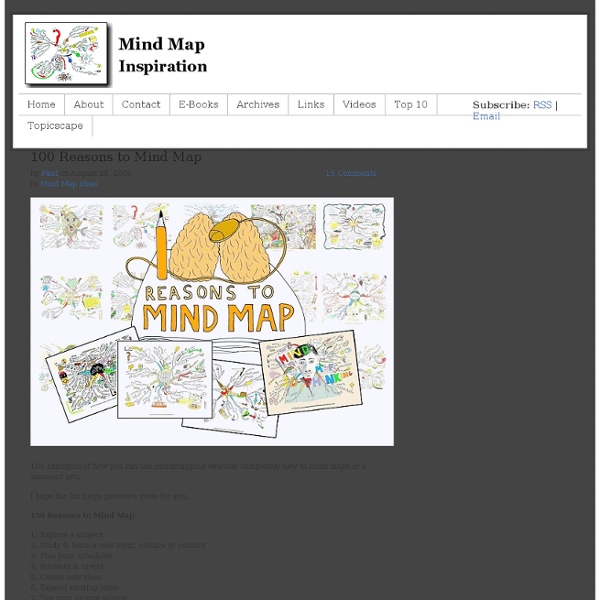



http://www.mindmapinspiration.com/100-reasons-to-mind-map-paul-foreman/
Related: Mind MappingThe Biggest Stumbling Blocks When You Start Mind Mapping Some people start mind mapping and they’re changed forever. They can’t stop raving about it. Then there’s another group of people, which you might be in. It’s the group that tries out mind mapping, but finds there’s something not quite working for them. If I’m describing you, read on. Draw A Creative Mind Map for Self Analysis Many personal development experts share about the benefits of using mind maps. My post today takes it one step further with how I have used the concept of mind mapping for self analysis. I also share illustrations from my personal art journal that I created some time ago. I drew them as part of my pre-vision board exercises. The (above) mind map picture that I did for self-analysis was my first.
99 Mind Mapping Resources, Tools, and Tips So, there you are staring at that black sheet of paper again. Or perhaps it's a black Word document on your computer screen. Whichever it may be, it's obvious you're about to take notes for that big essay assignment or group project, and you're not too excited about getting started! That's where a different kind of note taking comes in to play, one that is actually fun to do and will also help you to understand your notes better.
» 12 Essential Rules to Live More Like a Zen Monk “We have more possibilities available in each moment than we realize.” - Thich Nhat Hanh By Leo Babauta I’m not a Zen monk, nor will I ever become one. However, I find great inspiration in the way they try to live their lives: the simplicity of their lives, the concentration and mindfulness of every activity, the calm and peace they find in their days. You probably don’t want to become a Zen monk either, but you can live your life in a more Zen-like manner by following a few simple rules. What is Argument Mapping? Argument mapping is, roughly, making a picture of reasoning. More precisely, it is the graphical display of the structure of reasoning and argumentation. Typically, argument maps are box-and-arrow diagrams, a bit like flowcharts. Argument mapping belongs to a family of "thought mapping" techniques which includes concept mapping and mind mapping.
How to create killer mind maps for solving your problems Chic Thompson, in his new book, What a Great Idea 2.0: Unlocking Your Creativity in Business and in Life, devotes an entire chapter to idea mapping and how to get more out of it. One of the techniques he highlights is utilizing a series of trigger words or phrases to help you improve your effectiveness using mind maps for problem solving. Because mind mapping is based upon leveraging the mind’s powerful associative capabilities, I think this technique is particularly useful. In Thompson’s vernacular, a trigger word is the central word or concept that the middle of your mind map. He encourages the reader to generate several mind maps utilizing the following trigger words or phrases:
Concept maps or mind maps? the choice What are the differences between mind maps and concept maps? (click to see larger) Sometimes you will have no choice. In an educational setting, some educators require their students to make concept maps, others mandate mind maps. But most of the time we are free to choose.
Dan Roam’s SQVID tool In the Napkin Academy (see my earlier post where I’ve reviewed it) Dan Roam describes the SQVID as a visual thinking tool. (Btw, he had first described it in his book, “The Back of the Napkin”) The basic premise being that the SQVID helps one to take any subject and think about it in a variety of different ways, stretching your imagination, and helping in brainstorming. One exercise he encourages people to do is take a subject and apply the SQVID to it.